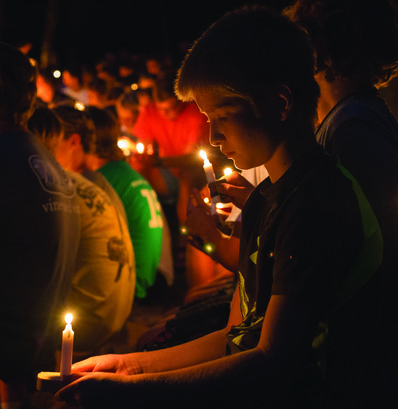Sacred Ground

On opening and closing days, loyal Falling Creek alumni — returning, sometimes after decades, to drop their sons off at camp — often remark about the relative sameness of life on top of the mountain. “This place hasn’t changed a bit,” they say. And they’re right, in some ways, it hasn’t. But they’re also mistaken, because in many ways it has.

Certainly, the notion of stability seems incompatible with that of progress. However, after nearly 50 years in operation, Falling Creek continues to demonstrate that what is implausible is not necessarily impossible. For, the camp’s continued success is due to its time-tested ability to honor tradition while fending off stagnation, to progress meaningfully, not just for progress’ sake.
Founded in 1969, Falling Creek is a relative newcomer to the summer camp capital that is Western North Carolina. As neighboring camps begin to plan for their centennials, Falling Creek is poised to charge into only the second half of its first century. But what Falling Creek lacks in age it more than makes up for with its robust pedigree and storied traditions. While such heritage is varied in source, much can be attributed to Camps Greystone, Sequoyah, and Mondamin, established in 1920, 1924, and 1922, respectively.
 The Falling Creek Camp bell serves as our camp clock, waking us up, shepherding us to activities, calling us to meals, and sending us to rest at the end of another full day. The sound of the bell is one alumni remember fondly.
The Falling Creek Camp bell serves as our camp clock, waking us up, shepherding us to activities, calling us to meals, and sending us to rest at the end of another full day. The sound of the bell is one alumni remember fondly.
Jim Miller, III worked at Camp Sequoyah in 1967, purchased the property for Falling Creek, and opened its gates in the summer of 1969. When Jim established Falling Creek, he borrowed traditions from Camp Greystone, the girls camp his family founded nearly five decades before. Green and Gold competition, a source of friendly rivalry between cabins, and within activities, is one such tradition. Honor Council, a camper-led leadership development program unique to Main Camp, is another.
Camp Sequoyah, before it closed its gates in 1978, shared with Falling Creek both its traditions and, in some cases, its counselors. When Chuck McGrady, a Sequoyah alumnus and eventual owner-director of Falling Creek, began as a counselor in 1979, he remembered feeling oddly at home. “When I arrived at Falling Creek, it all came together,” he says. That feeling was hardly coincidental. Candlelight campfire, a time-honored conclusion to our longer sessions, is a product of Camp Sequoyah, as is Falling Creek’s Native American-themed tribal structure and Indian Lore program. Three times daily, the legacy of Camp Sequoyah lives on when the blessings are sung before each meal at Blake Dining Hall.
Still other traditions central to the contemporary Falling Creek experience harken from Camp Mondamin, another boys’ camp situated along the western shores of Lake Summit. From Mondamin comes Morning Assembly, a program following breakfast during which the entire camp community gathers for skits and songs. Falling Creek’s paddling program finds inspiration from Camp Mondamin’s distinguished whitewater heritage.

For every borrowed tradition there exists more than enough unique to Falling Creek. Wild, Wild, West and Deep Woods Capture the Flag, two favorite all-camp games played several times each summer, are longtime favorites. A glance at the porch of the Landsports Hut reveals a list of names by year; these are the winners of Falling Creek’s Ironman triathlon, held annually during the camp’s longest session.
In appreciation of the importance of nurturing free choice and decision-making in the development of young men, Falling Creek stepped outside the box in a big way. To both campers and the casual observer, camp remains free of the distractions technology and social media can bring. Behind the scenes, however, Falling Creek has developed an advanced proprietary attendance, progression, trip planning, and medical tracking system.

In a world that is becoming increasingly structured in the neighborhood and schoolyard, the implementation of this tablet-based camper management system allows boys the freedom to choose their own adventures — a hallmark of Falling Creek — while remaining accounted for during the day.
For many Falling Creek alumni, the Candlelight campfire is among their most cherished memories. Here, campers are reminded that a single candle — representative of one’s talents and abilities — light the world. Though deference to the sanctity of this ritual remains important, there is value in striving to keep camp both fresh and meaningful. In a nod to both storied tradition and meaningful progress, we have introduced a candle-lit procession at the conclusion of each week’s campfire.

Adaptation of the Honor Creed into the Falling Creek Code; a creative solution to the maintenance of a balance between autonomy and safety; the inclusion of candlelight in campfire on a weekly basis. These are just three examples of Falling Creek’s relentless effort to adapt for an exciting future. There are countless more, many of which are illustrated throughout this publication. Falling Creek’s success demonstrates that such progress can coexist with longstanding tradition. And together, they will carry camp into an impactful future with our prime purpose in mind: the development of great young men.
There is a place in North Carolina where my friends and I like to go, and my spirit never leaves there. -Verse from the FCC version of “Will the Circle Be Unbroken”
